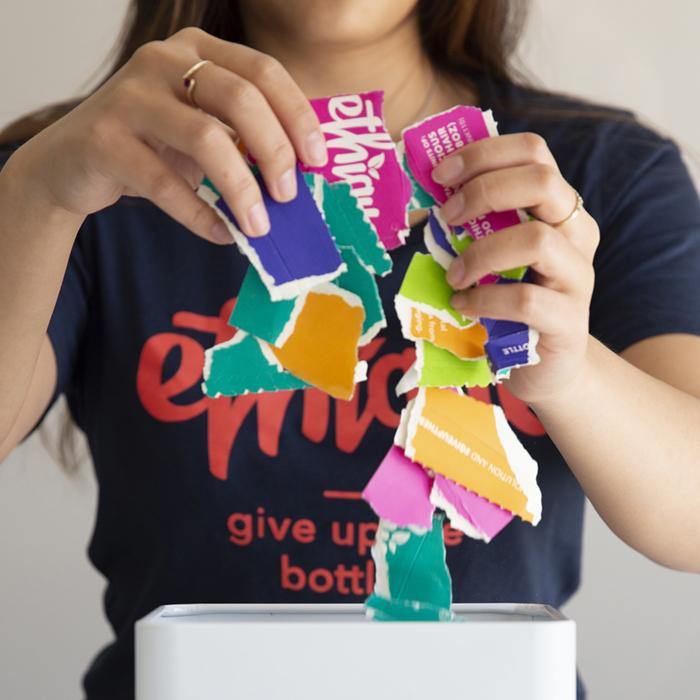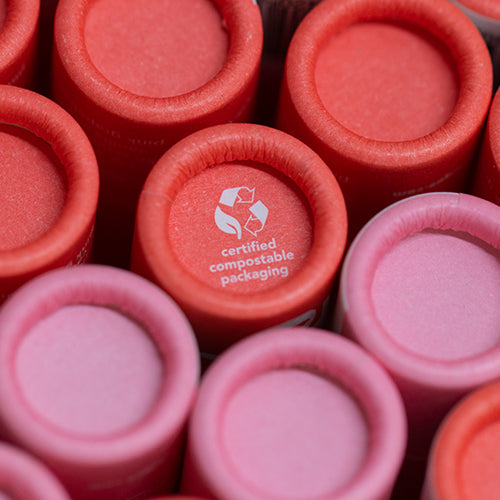
40% of all plastic produced is single-use, usually from product packaging. When we see a new plastic-free or compostable alternative we get a little excited. But how many of these new wonder-innovations are actually plastic-free, or actually compostable? So many of these little cardboard alternatives come with a hidden secret – a plastic lining.
We’re super proud of our certified home-compostable packaging. When you are done with your box, you simply rip it up into tiny pieces and pop it into your compost bin Or you can dig a hole in the garden and pop the pieces in there, or failing that, bury it in one of your houseplant pots. But, does this mean that you can bury all your cardboard packaging and that it will compost? Nope.
This is because of the elephant in the room - or should we say, the secret lining on most cardboard packaging - plastic.
But why would a simple cardboard box need plastic? For some, it’s purely for aesthetics, like sprucing up a dull box so it rocks a new shiny shelf-ready look to entice customers. For others, the layer of plastic is found on the inside. Typically, the layer of plastic functions as a moisture barrier and helps with tear strength, durability and the ability to be heat sealed. Of course, sometimes it’s on both the inside and the outside of the packaging.
This hidden plastic layer renders the cardboard box uncompostable. Worse, in some regions, it will even stop you from being able to recycle it.
What’s the big deal?
There’s no denying that cardboard is compostable (being made from, you know, plants), but plastics are not. Compostable cardboard can be turned into compost, at home and commercially. If the cardboard has been sealed with a layer of plastic, that layer remains after the board has composted. Since plastics break up into smaller fragments rather than biodegrade, it can eventually end up making its way into a waterway, a lake, or the ocean where 8 million tonnes of plastic ends up. And with recent studies indicating that the average person could be ingesting as much as 5 grams of plastic every week, why would we help ourselves consume more?

What are the biggest offenders?
Found in pantries, fridges and kids lunch boxes all over the world, the much-loved juice box is much like the paper coffee cup in that it is lined with plastic (and in the juice boxes’ case, aluminum also). The packaging (75% paper, 20% plastic, 5% aluminum) helps preserve the juice inside so that it has a longer shelf life and stops it from leaking onto shelves. This can be said for milk cartons also as if they were straight cardboard, they would leak milk everywhere very quickly. So, a lot of councils cannot actually recycle these and they get sent straight to a landfill.
Other offenders that aren’t compostable:
- Milk cartons
- Soup cartons
- ‘Paper’ coffee cups
- Fast food containers (ie, a chip (french fry) box)
- Frozen food containers (the plastic helps stop freezer burn)
- Magazines and shiny catalogues (uncoated newspaper is fine).
- Glossy gift bags
- Receipts – although not cardboard, these are the biggest offenders! Most are lined with plastic; bisphenol A (BPA) or bisphenol S (BPS). These can be harmful if they are released into the environment or ingested in large quantities. Many stores now send you an email receipt or give you the choice of whether to take a printed receipt.
How to tell if your cardboard packaging is compostable:
- Does it have a certified compostable symbol? If so, yay that one is easy! If not, simply soak the cardboard packaging in some water overnight. If there is plastic hiding in there, the plastic layer will pull away from the cardboard. Squeeze the water out of the card and pop into the compost.
- Contact the retailer or manufacturer and ask what their packaging is made from and if there are any hidden plastics that they are aware of. What do they coat their board with? How is that paper lip balm tube not leaking product on hot days, is it plastic-lined or wax-lined?
What can you do?
- Buy liquid products in glass or other reusable materials - there are some shops which have refillable juice and milk.
- Homemade – or better yet, make your own nut or oat milks and juice. It’s a lot easier than you think and much more cost effective too.
- Use reusables. Take your reusable cup to the coffee shop rather than using a single-use paper cup and take your own container for takeaways.
- Opt-out of mailed catalogues and read them online.
- Hold the brand accountable if they are claiming that their packaging is “Earth-friendly” and “compostable” if you rip it apart and see a liner of plastic.
PS: Canned soft drinks are lined with plastic to prevent the soda from reacting with the metal. Check out this video!
Sources:
- Geyer, R., Jambeck, J. R., & Law, K. L. (2017). Production, use, and fate of all plastics ever made. Science advances, 3(7), e1700782. doi:10.1126/sciadv.1700782
- Hannah Ritchie and Max Roser (2020) - "Plastic Pollution". Published online at OurWorldInData.org.
- The University Of Newcastle Australia – “Plastic ingestion by people could be equating to a credit card a week”. Published online at Newcastle.edu.au
- Tetra Pak – “Tetra Pak carton 100% recyclable” – Published online at tetrapak.com
- Wikipedia – “Plastic-coated paper” – Published online at wikiepedia.org


